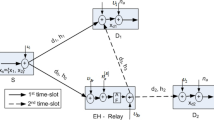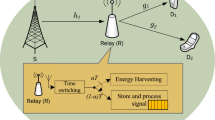Abstract
In this paper, we investigate the effects of residual-transmit radio-frequency impairments on the downlink non-orthogonal multiple access system with perfect successive interference cancellation using an energy-harvesting (EH) relay in which nodes in the network are equipped with a single antenna. The source node communicates with two users with the help of the amplify-and-forward EH relay node. In addition, both the power-splitting relaying (PSR) and time-switching relaying (TSR) protocols are examined. To evaluate the performance of the proposed system, closed-form expressions of the outage performance and the available throughput are derived over Rayleigh fading channels. Moreover, the accuracy of analytical results is verified by a Monte Carlo simulation. The results show the effects of various parameters, such as power allocation factors, the relay node location, data rate, transmit hardware impairment level, and power allocation factors on the outage performance (\({\mathcal {OP}}\)) and throughput with two users for both PSR and TSR architectures in the presence of hardware impairments. Furthermore, these results are compared with performance of orthogonal multiple access (OMA) EH relaying system.






Similar content being viewed by others
References
Ding, Z., Liu, Y., Choi, J., Sun, Q., & Elkashlan, M. (2017). Application of non-orthogonal multiple access in LTE and 5G networks. IEEE Communications Magazine, 55, 185–191.
Riazul Islam, S. M., Avazov, N., & Dobre, O. A. (2017). Power-domain non-orthogonal multiple access (NOMA) in 5G systems: Potentials and challenges. IEEE Communications Surveys and Tutorials, 19, 721–742.
Ding, Z., Peng, M., & Poor, H. V. (2015). Cooperative non-orthogonal multiple access in 5G systems. IEEE Communications Letters, 19(8), 1462–1465.
Fazlul Kader, Md, Shahab, M. B., & Shin, S. Y. (2017). Exploiting non-orthogonal multiple Access in cooperative relay sharing. IEEE Communications Letters, 27, 1159–1162.
Liang, X., Wu, Y., Ng, D. W. H., Zuo, Y., Jin, S., Zhu, H. (2017). Outage performance for cooperative NOMA transmission with an AF relay. IEEE Communications Letters, 21, 2428–2431.
Liu, Y., Ding, Z., Elkashlan, M., & Yuan, J. (2016). Non-orthogonal multiple access in large-scale underlay cognitive radio networks. IEEE Transactions on Vehicular Technology, 65, 10152–10157.
Paradiso, J., & Starner, T. (2005). Energy scavenging for mobile and wireless electronics. IEEE Pervasive Computing, 4(1), 18–27.
Varshney, L. (2008). Transporting information and energy simultaneously. In IEEE international symposium on information theory, 2008. ISIT 2008 (pp. 1612–1616).
Nasir, A. A., & Durrani, S. (2013). Relaying protocols for wireless energy harvesting and information processing. IEEE Transactions on Wireless Communications, 12(7), 3622–3636.
Guo, W., & Wang, Y. (2017). Cooperative non-orthogonal multiple access with energy harvesting. Information, 8(3). https://doi.org/10.3390/info8030111.
Ha, D.-B., & Nguyen, S. Q. (2017). Outage performance of energy harvesting DF relaying NOMA networks. Mobile Networks and Applications. https://doi.org/10.1007/s11036-017-0922-x.
Han, W., Ge, J., & Men, J. (2016). Performance analysis for NOMA energy harvesting relaying networks with transmit antenna selection and maximal-ratio combining over Nakagami-m fading. IET Communications, 10, 2687–2693.
Studer, C., Wenk, M., & Burg, A. (2010). MIMO transmission with residual transmit-RF impairments. In Proceeding of the ITG/IEEE workshop smart antennas (WSA) (pp. 189–196).
Studer, C., Wenk, M., Burg, A. (2010). MIMO transmission with residual transmit-RF impairments. In International ITG workshop on smart antennas (WSA 2010).
Matthaiou, M., Papadogiannis, A., Bjornson, E., & Debbah, M. (2013). Two-way relaying under the presence of relay transceiver hardware impairments. IEEE Communications Letters, 17(6), 91–94.
Balatsoukas-Stimming, A., Austin, A. C. M., Belanovic, P., & Burg, A. (2014). Baseband and RF hardware impairments in full-duplex wireless systems: Experimental characterisation and suppression. arXiv:1412.4542.pdf.
Zhang, X., Matthaiou, M., Coldrey, M., & Bjornson, E. (2014). Impact of residual transmit RF impairments on training-based MIMO systems. arXiv:1406.3638.pdf.
Gustavsson, U., Sanchez-Perez, C., Eriksson, T., Athley, F., Durisi, G., Landin, P., Hausmair, K., Fager, C., & Svensson, L. (2014). On the impact of hardware impairments on massive MIMO. arXiv:1411.7197.pdf.
Zarei, S., Gerstacker, W. H., & Aulin, J. (2017). Multi-cell massive MIMO systems with hardware impairments: Uplink-downlink duality and downlink precoding. IEEE Transactions on Wireless Communications, 16(8), 5115–5130.
Tuan, V. P., & Kong, H. Y. (2017). Impact of residual transmit RF impairments on energy harvesting relay selection systems. International Journal of Electronics, 104(6), 928–941.
Gradshteyn, I. S., & Ryzhik, I. M. (2014). Table of intergrals, series, and products (8th ed.). London: Academic.
Author information
Authors and Affiliations
Corresponding author
Appendices
Appendix 1: Proof of Theorem 1
This appendix derives \(OP_1^q\) in (26) at \({\mathcal {U}}_1\) in a cooperative NOMA–EH network employing perfect SIC with the residual transmit hardware impairment. According to (25), the factor \({\alpha _1} - {\gamma _1}\left( {{\alpha _2} + {K^2}} \right)\) can be positive or negative; thus, we consider the following two cases. If \({K^2} \ge \frac{{{\alpha _1}}}{{{\gamma _1}}} - {\alpha _2}\) the outage probability at \({\mathcal {U}}_1\) of PSR and TSR protocols is expressed as
If \({K^2} \ge \frac{{{\alpha _1}}}{{{\gamma _1}}} - {\alpha _2}\), from (25) let denotes \(X = {g_0}\) and \(Y = {g_1}\), the outage probability at \({\mathcal {U}}_1\) with PSR and TSR protocols is expressed as
By using [21, Eq. (3.324.1)], the OP of \({\mathcal {U}}_1\) in this case can be expressed as in (26). This ends the proof of Theorem 1.
Appendix 2: Proof of Theorem 2
This appendix derives \(OP_2^q\) in (29) at the user \({\mathcal {U}}_2\) in a cooperative NOMA–EH network employing perfect SIC with the residual transmit hardware impairment. According to (28), the factor \({\alpha _1} - {\gamma _1}\left( {{\alpha _2} + {K^2}} \right)\) can be positive or negative; thus, we consider the following cases.
In the case \(\frac{{{\alpha _1}}}{{{\gamma _1}}} - {\alpha _2} \le {K^2} \le \frac{{{\alpha _2}}}{{{\gamma _2}}}\), \(OP_2^q\) at \({\mathcal {U}}_2\) can be expressed as
In the case \({K^2} \ge \max \left\{ {\frac{{{\alpha _1}}}{{{\gamma _1}}} - {\alpha _2},\frac{{{\alpha _2}}}{{{\gamma _2}}}} \right\}\) from (28), \(OP_2^q\) can be expressed as
In the case \(\frac{{{\alpha _2}}}{{{\gamma _2}}} \le {K^2} \le \frac{{{\alpha _1}}}{{{\gamma _1}}} - {\alpha _2}\) from (28), \(OP_2^q\) can be expressed as
In the case \({K^2} \le \min \left\{ {\frac{{{\alpha _2}}}{{{\gamma _2}}},\frac{{{\alpha _1}}}{{{\gamma _1}}} - {\alpha _2}} \right\}\), from (28),let denotes \(X = {g_0}\) and \(Z = {g_2}\), \(OP_2^q\) can be expressed as
According to CDF and PDF in (1a) and (1b), (37) can be given by
By using [21, Eq. (3.324.1)], the OP of \({\mathcal {U}}_2\) in this case can be expressed as in (29). This ends the proof of Theorem 2.
Rights and permissions
About this article
Cite this article
Le, T.A., Kong, H.Y. Performance analysis of downlink NOMA–EH relaying network in the presence of residual transmit RF hardware impairments. Wireless Netw 26, 1045–1055 (2020). https://doi.org/10.1007/s11276-018-1851-8
Published:
Issue Date:
DOI: https://doi.org/10.1007/s11276-018-1851-8




